History of the Air Force and Air Defense of Yugoslavia Part of 3. Guerrilla Aviation (1942-1945's)
However, it was at the end of 1941 that the information appeared that in western Bosnia several ground sites were organized by the partisans. At the same time, propaganda work began among pilots of the newly created Croatian Air Force. The propaganda was more than effective because the flight personnel of these Air Forces was staffed by pilots of the Royal Air Forces of Yugoslavia, who for various reasons returned to service.
Hard work soon brought the first results. On Saturday 23 in May 1942 of the year in 9: 30 from the airfield near the town of Banja Luka took off the Croatian biplane Potez XXV. This unarmed aircraft was supposed to deliver supplies to a remote garrison in Sansk-Most. A little later another plane took off from the same airfield - Brege XIX with a similar task. Both aircraft, however, did not arrive at their destination, but landed on a partisan field site.
These two biplanes and became the first aircraft of the so-called "partisan air force." Immediately all available air defense assets were brought to high alert. Croatian leaders seriously feared a bomb strike on their capital, Zagreb. Not only that, soon the anti-aircraft gunners received orders: to shoot at any biplane appearing in sight.
In addition, to search for planes, a serious search campaign was organized, for which large forces of the army, police and security services were attracted, and of course, all available air forces. This whole "epic" ended with the fact that on May 29, Croatian pilots stated that both aircraft were destroyed during the bombardment of a "suspicious" site in the area of Urie.
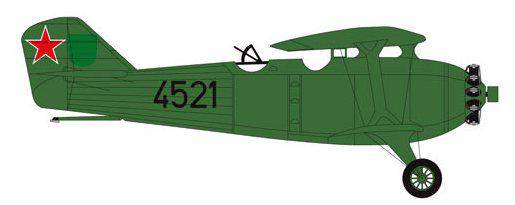
In fact, the planes were safely covered by partisans who began preparing for combat missions. The main problem at first was the lack of fuel, but it was soon resolved by purchasing ordinary motor gasoline. Much more trouble brought the lack of weapons. The side shooters of both airplanes established "production" of improvised bombs. These 10-kg bombs were made of water pipes; For 10 days, 270 pieces of such ammunition were produced. A MG-34 machine gun was installed in the rear cockpit of Potez, and large red stars were drawn on the Breguet keel.
The first combat departure of the guerrilla aircraft occurred on 4 on June 1942, when Potez launched a bomb attack on a Croatian convoy. The enemy’s losses were 9 people, and one of them was German. At the same time, Breguet struck at the former “home” airfield in Banja - Luka. During the third approach, gunned down anti-aircraft gunners hit a low-speed aircraft. The pilot was injured, the plane was seriously damaged, but he tried to reach the territory controlled by the partisans. But after the engine stopped, there was only one way out - emergency landing. The landing site was immediately surrounded by police. After a short firefight, the pilot shot himself dead, and the wounded Letnab was captured. Subsequently, he was shot by conviction of the military court as a deserter.
For the Croats, the appearance of partisan aircraft was a complete surprise, and therefore the search was resumed with a new force. A pilot of one million Croatian kunas was awarded to the pilot's head. However, already on June 7, the "elusive avenger" is bombing the positions of the Croatian troops.
However, the search ring was narrowed, and in a week the plane would have to fly to a new site. Along the way, the pilot struck a bombing attack on a discovered column of Croats. 5 July marked the first night departure of the "partisan".
However, with the complete domination of enemy aviation in the air, the outcome came very soon. 6 July 1942, the attack aircraft ready for departure was discovered and destroyed by a German FW-58 patrol aircraft.

A number of measures were taken directly in the units of Croatian aviation to exclude such cases in the future.
The situation in occupied Yugoslavia began to change dramatically only after the withdrawal from the war in Italy’s 1943 year. The Italian corps, which was on the territory of the country, began to disarm everyone and everything: it was done by both the Germans and the Croats, well, of course, the partisans. During this period, the quiet collapse of the Croatian military aviation began. Only in June, 1943 of the year from one of the units in the Zagreb region deserted 60 people (and both pilots and technicians).
Something got and aircraft. Thus, on the Italian base of hydroaviation in Divoulje (near the city of Split), the partisans were captured in the non-flying state Consolidated Fleet. 10 September 1943 pilot Cyril with the help of Italian mechanics drove the plane into the Seget Bay - Vranitsa, where an improvised partisan hydro base was established. He then performed an 26 departure on this machine, mostly courier, since the plane was unarmed. October 6 1943 was shot down from the ground with fire from the ground, and both the pilot and the passenger, the commander of the 8 partisan detachment, were killed during an emergency landing.
September 11 at the Italian air base of Gorizia by the Slovenian partisans captured 11 Italian aircraft. However, when the Germans approached 10, the aircraft were burned, and one ("Saiman") was overtaken on a field site in the area of the partisan headquarters of the Maritime Region. From September 20, this aircraft began to make regular courier flights to the General Headquarters of the Yugoslav Liberation Front. The aircraft was not repainted, but on the fuselage caused three-headed. However, this plane was not the last in the hands of the partisans. At about the same time, two connected planes were captured by partisans at an airfield near the city of Rijeka: Fizler 156 Story and Caproni Sa. 164.
9 October 1943 from the Zagreb airfield deserted on his Bücker Jungmann pilot Josip Klococnik, and on October 29 the head of staff (!) Of the Croatian Air Force Colonel Frano Pirk flew to the partisans on FL.3 training aircraft.
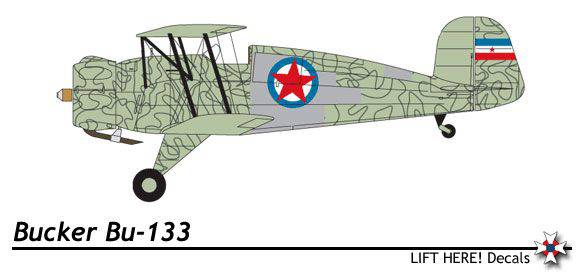
The further fate of this person is very interesting. After the flight, he became the right hand of Tito and was appointed head of the aviation department of the General Staff, and later became the first commander of the JNA Air Force. From 1946, he falls into disgrace and is sent as ambassador to Argentina. He died in 1954 in Ljubljana with the rank of Major General of the Yugoslav Aviation.
Since October 14, peculiar training courses for pilots and technicians for partisan air forces were organized at the air base in Livno. They underwent basic flight training on FL.3 while there was enough fuel and oil. About 60 people attended the courses.
13 November 1943 of the year into the hands of the partisans got a real combat aircraft: it was a Dornier Do.17 bomber hijacked by a Croatian pilot. For this aircraft, the command of the partisans had prepared a special task: he had to transfer representatives of the Yugoslav headquarters to talks with the allies. However, 28 November was a tragedy: during the landing of the delegation on the partisan strip, the car was discovered and attacked by the German Henschel reconnaissance aircraft Hs-126. The losses of the partisans were very serious: several members of the General Staff and two British advisers died. Naturally, the partisan Dornier burned down.
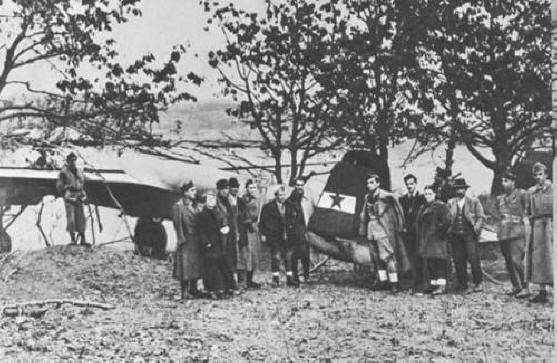
However, the decisive German offensive on the partisan positions and the front began to approach Livno in December. In view of this, the only aircraft flew to Glamoch (however, it was burned there when the Germans approached). In the defense of Livno, the 34 man was killed from the courses.
However, the work of "partisan air force" in Yugoslavia did not stop. Moreover, in the 1944, air battles were also marked! Well, first things first.
On the night of 20 on September 21, the 1944 guerrilla unit captured the Zalusana airfield. Among other things, three Morane Salunier MS.406 C1 fighters from the Croatian Air Force were captured here. Within a few days, these cars with new identification marks (a large flag on the keel and red stars on the wings) began to make combat missions.
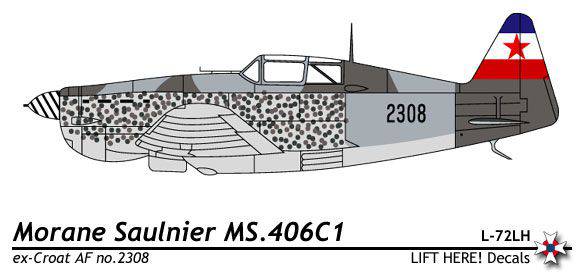
And they were brought into one unit, proudly called the "Bosnian Aviation Corps". For a couple of days, the guerrilla pilots made 23 relegation to cover the combat area. But the most interesting thing about all this is that the pilots managed to win at least one victory in the air! On one of the days, Sergeant Suleiman Sulio Selimbegovic in a car with the 2308 number near Banja Luka shot down the Croatian Air Force transport junkers W-34. Another of his applications - over the Croatian Fiat G.50 has not received confirmation. 25 September 1944 of the year during the maintenance of the ground one aircraft burned.
The remaining two fighters with the approach of the front were transferred to the airfield near Sanski Most. The last report on partisan "morahs" dates from the end of October 1944, when they supported the offensive in the Travnik area.
But this was not an isolated case of the capture of enemy aircraft at home based airfields. At the end of 1944, the partisans captured the Kovin airfield (in 50 km east of Belgrade), which had several Me-109G and one FW-190 F-8. Yugoslav pilots overtook cars at the airport of Zemun, where a liaison squadron was organized at their base.
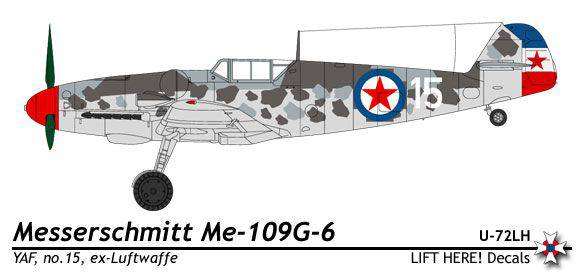
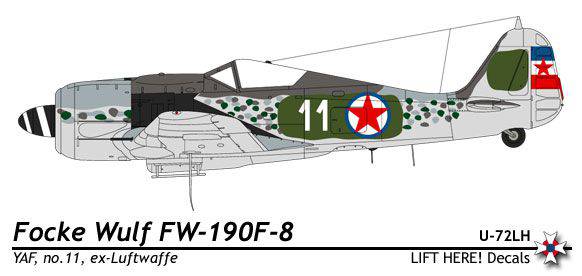
The desertion of Croatian pilots continued. So, September 2 1944 of the year flew over to the side of the Croatian partisans Fiat G.50bis. The car used for courier flights until the end of the war. And now the plane is in the exposition of the Aviation Museum in Belgrade.
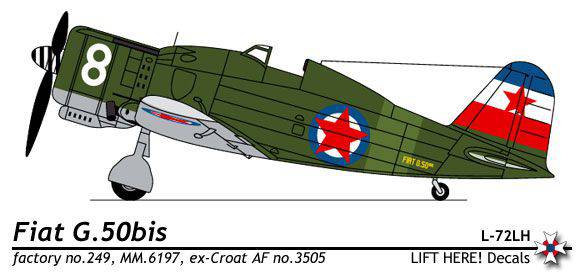
Guerrilla aviation was replenished in other ways. At the end of February 1945, a young German pilot, during the distilling of the Ju-87B2, made an error landing on a partisan airfield. The pilot was naturally captured, and the car was included in the communications squadron.
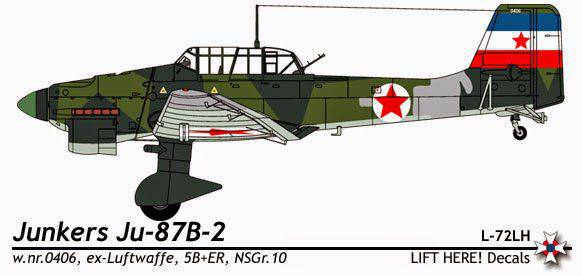
Apparently, this was the last case of the replenishment of guerrilla aviation.
However, it was clear to all that partisans could not do without the help of Allied aviation. Especially since the nearby bases were in liberated Italy. The headquarters of the Air Force Tito moved to southern Italy, where, under the guidance of English instructors and on British aircraft, Yugoslav units were organized as part of the RAF.
22 April 1944 was the first Yugoslav unit of the British Air Force, the 352 Fighter Yugoslav Squadron. It was also the first unit formed on the shores of the Mediterranean. The squadron was based on Hawker Hurricane fighters, which were later replaced in June by the Supermarine Spitfire. 1 On July 1944, the second Yugoslav unit of the British Air Force, the 351 Fighter Yugoslav Squadron, was formed. From the time of its formation and to the end, the squadron was based on Hawker Hurricane fighters (first models IIC, then IV).
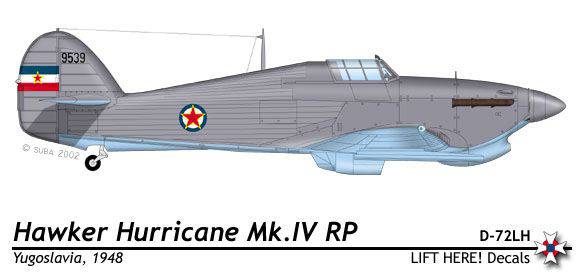
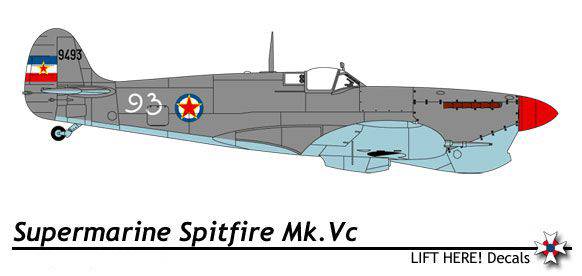
In August, the squadron 1944 relocated to Italy as part of the 281 th wing. The base served as the island of Vis, which became the official base from 1 in January 1945.
The squadrons were divided into two squads A and B, each of which had 8 fighters. The attendants were recruited from the Royal Air Force of Yugoslavia, and the crew consisted of the personnel of the NOAJ 1 air base.
During the war years, the 351 Squadron made the 971 take off, completing the 226 missions, which included air support for ground troops, covering aviation groups, reconnaissance flights, and so on. The squadron suffered losses in the amount of 23 pilots, four of whom died in battle (including the commander). The 352 Squadron made 1210 sorties by completing 367 missions. The bases in Cannes, on the island of Vis and in Zemunik were used as air bases. The squadron suffered losses in the amount of 27 pilots, of which 10 died in battle.
Headquarters were moved to Yugoslavia from Italy in April 1945. After the end of the war, the 16 of May 1945 squadrons were expelled from the RAF: On May 18, after their unification, the 1 th Fighter Wing was created.
Since February, Soviet long-range aviation has operated in Intersa guerrillas; Lee-1944НБ and В-2 bombers flew from airfields in Ukraine (parasailing weapons, medical supplies, etc.) to the partisans. In March - June, 25 of the USSR provided assistance to its allies on the balconies and from the airfields of Italy, where the Lee-1944 transport was based. The significance of this assistance is evidenced by the fact that 2’s June 3 was evacuated by the Soviet Lee-1944 of Josip Broz Tito and his closest associates. The Germans then carried out an operation in the territory of Western Bosnia and Krajina, the purpose of which was to capture or destroy Tito. From July 2 in the interests of the partisans from the airfield in Bari operated a task force under the command of Colonel Sokolov as part of 1944 transport Lee-12 and C-2 and 47 Yak-12D fighters of the Red Army Air Force.
By September, the 1944 of NOAJ was a significant military force (50 divisions), which liberated a large part of Yugoslavia from the invaders. NOAU had four air squadrons. The Red Army, meanwhile, advanced through the territory of Romania and Bulgaria, creating the conditions for more substantial air support for parts of the NOAA. By agreement of October 16 1944. The 10-I Guards Assault and 236-I Fighter Divisions of the 17-th Air Army were transferred to NOAJ. The Air Force of Yugoslavia intensified 125 attack aircraft Il / VI-2, 123 fighters Yak-1 / 3 / 7 / 9 and five U-2.
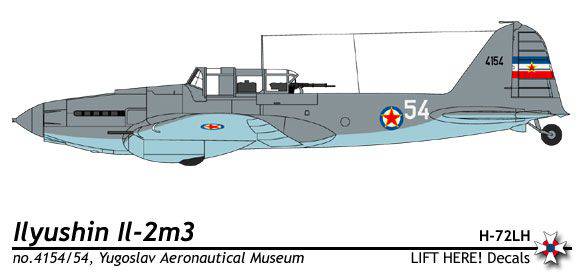
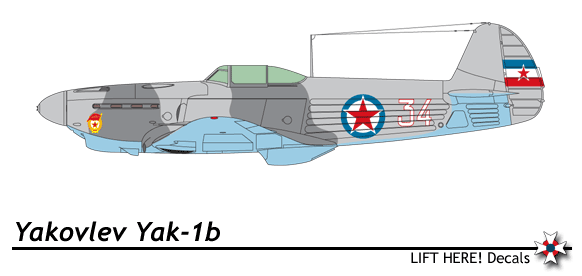


These aircraft were turned to the formation of the 42-th Aviation and 11-th Fighter Division NOAJ. Until March, 1945 served in the Yugoslav squadrons as Soviet pilots, who not only helped their Yugoslav colleagues in the development of new aircraft, but also took part in the hostilities. The help of the pilots of the Air Force of the spacecraft was necessary, because the Yugoslav pilots sent to the USSR had not yet completed training. In aviation schools in Krasnodar (fighters), Grozny (attack aircraft), Engels (bombers) and Moscow (transport aircraft) before 1948, 2500 trained Yugoslav pilots, technicians and other aviation specialists.
Cooperation NOAU with the USSR was not one-sided. For example, the guerrillas handed over the USSR to the B-17 and B-24 bombers, which turned out to be in Yugoslavia in various ways.
By a partisan order from 23 in October 1944, all pilots of the former Air Force of the Kingdom of Yugoslavia who were in the liberated territory were ordered to appear in Pancevo (Belgrade neighborhood) and take part in the final liberation of the Motherland from the invaders. The 72 pilot responded to the call, but instead of receiving an assignment to the military units, the communists declared them traitors and shot without trial near the village of Yabuk, not far from the airfield. Probably there were fears that the pilots would facilitate the return of King Peter to Yugoslavia. This attitude of Tito (by origin he was a Croat) to the pilots of the Croatian Air Force, who left ZNDH en masse, was out of the question. Thus, the former ZNDH General Franz Pirc became the first commander of the Air Force of the new Yugoslavia ...
Information